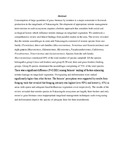Synthesis Of Termite Studies Conducted In The Nakasongola Ecosystem In Uganda

View/
Date
2011Author
Mugerwa, Swidiq
Nyangito, M.M.
Mpairwe, D.
Type
PresentationLanguage
enMetadata
Show full item recordAbstract
Consumption of large quantities of grass biomass by termites is a major constraint to livestock
production in the rangelands of Nakasongola. Development of appropriate termite management
interventions in such ecosystems requires a holistic approach that considers both social and
ecological factors which influence termite damage on rangeland vegetation. We undertook a
comprehensive review and linked findings from parallel studies in the area. The review revealed
that the termite assemblages in semi-arid Nakasongola consisted of sixteen species from one
family (Termitidae), three sub-families (Macrotermitinae, Termitinae and Nasutitermitinae) and
eight genera (Macrotermes, Odontotermes, Microtermes, Pseudocanthotermes, Cubitermes,
Procubitermes, Trinervitermes and Ancistrotermes). Species from the sub-family
Macrotermitinae constituted 69% of the total number of species sampled. All the species
belonged to group I (true soil feeders) and group II (Wood, litter and grass feeders) feeding
groups. Group II species dominated the assemblages comprising of 75% of the total species.
There was a significant difference (P>0.0001) among farmers’ ranking of factors enhancing
termite damage on rangeland vegetation. Overgrazing and deforestation were ranked
significantly higher than other factors. The farmers’ perceptions were supported by results from
foraging trials that revealed that foraging intensity was highest (over 90%) and lowest (≤ 45%) in
areas with sparse and adequate basal herbaceous vegetation cover respectively. The results of the
review revealed that termite species in Nakasongola ecosystem are largely litter feeders and only
resort to grass biomass once inappropriate rangeland management techniques such overgrazing
and deforestation deprive the species of adequate litter for their nourishment.
